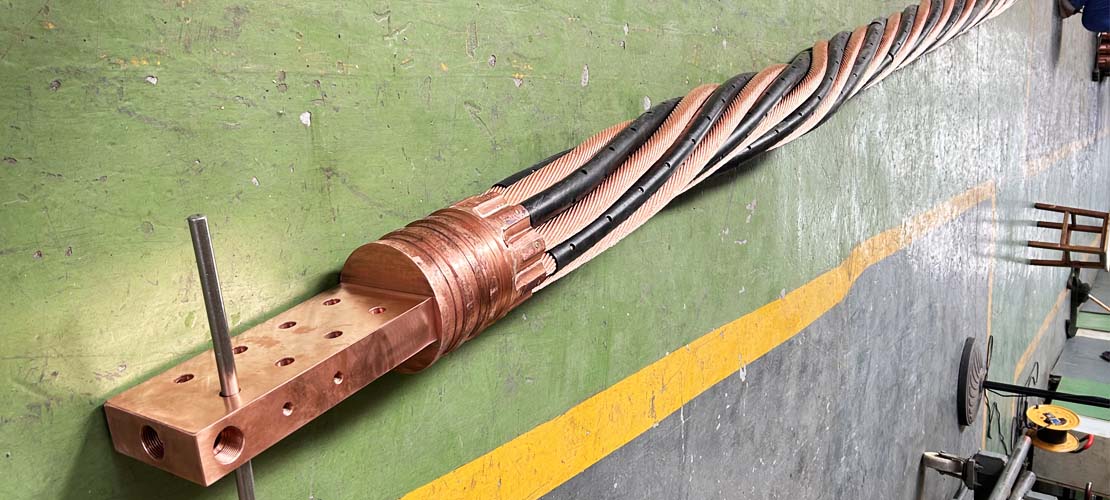Dec. 21, 2024

Water-cooled cable is one of the important equipment for transmitting power and signals. In order to ensure the normal operation and long-term stability of the cable, the water-cooled cable structure came into being.
This article will introduce the structural principle, working principle and application scope of water-cooled cable from three aspects.
Water-cooled cable introduces coolant into the cable structure, and reduces the temperature of the cable through the circulation of coolant, thereby improving the conductivity and operation efficiency of the cable. The structure of water-cooled cable mainly includes four parts: conductor, insulation layer, coolant channel and outer protective layer.
1. Conductor: The conductor of water-cooled cable generally adopts high conductivity materials, such as copper or aluminum, to ensure that the current can be transmitted smoothly. The larger the cross-sectional area of the conductor, the stronger the transmission capacity of the cable.
2. Insulation layer: In order to prevent the current from flowing out of the conductor and protect the conductor from the influence of the external environment, the conductor surface of the water-cooled cable will be covered with an insulation layer. Commonly used insulating materials are polyethylene, polyvinyl chloride, etc.
3. Coolant channel: The core part of the water-cooled cable is the coolant channel, through which the coolant is introduced into the cable structure. The coolant channel is generally located between the conductor and the insulation layer, and can adopt different structural forms, such as spiral, straight, etc. The design of the coolant channel should take into account the principles of fluid mechanics to ensure that the coolant can flow evenly through the conductor to achieve effective cooling effect.
4. Outer protective layer: In order to protect the cable structure from damage and erosion by the external environment, a protective layer is added to the outside of the water-cooled cable. Commonly used protective layer materials include polyvinyl chloride, polyethylene, etc., and their thickness and hardness should be determined according to the specific use environment.
The working principle of water-cooled cable is based on the principles of heat conduction and fluid mechanics. When current passes through the conductor, heat is generated, and the heat causes the cable temperature to rise. In order to prevent the cable from being damaged due to overheating, the water-cooled cable removes the heat generated by the cable through the circulation of coolant.
Specifically, when the coolant flows through the coolant channel of the cable, the coolant absorbs the heat generated by the cable and then takes the heat away. After passing through the heat exchanger, the coolant will be cooled by the cooler and then circulate again to form a closed-loop system. In this way, the temperature of the cable can be kept within a safe range to ensure the normal operation of the cable.
Water-cooled cables are widely used in high-power electrical equipment and high-temperature environments. They can effectively reduce the temperature of the cable and improve the working efficiency and reliability of the equipment. The following are several common application areas of water-cooled cables:
1. Power transmission: Water-cooled cables can be used in transmission lines, especially for long-distance transmission and high-voltage transmission. By reducing the temperature of the cable, water-cooled cables can improve transmission efficiency and transmission capacity.
2. Industrial equipment: In some high-power industrial equipment (such as AC and DC steelmaking arc furnaces, ladle refining furnaces, submerged arc furnaces, electric slag furnaces, resistance furnaces, submerged arc furnaces water cooled cables and induction furnaces), due to the large current, overheating is easy to occur. The use of water-cooled cables can effectively cool the equipment and improve the working efficiency and reliability of the equipment.
3. Automotive electronic systems: In the electronic systems of some high-performance cars, due to the high power density, the cables are easily affected by high temperatures. The use of water-cooled cables can effectively reduce the temperature of the cables and improve the performance and reliability of automotive electronic systems.
The structural principle of water-cooled cables is to introduce coolant into the cable structure and reduce the temperature of the cable through the circulation of the coolant. Water-cooled cables work through the principles of heat conduction and fluid mechanics, which can effectively reduce the temperature of the cables and improve the working efficiency and reliability of the cables.
Water-cooled cables are widely used in power transmission, industrial equipment, automotive electronic systems and other fields to meet the needs of high-power equipment and high-temperature environments. In future development, water-cooled cables are expected to play an important role in more fields and improve the efficiency of power transmission and equipment operation.
Previous: DC Arc Furnace Steelmaking Technology
Latest News
Latest Products
Customized metallurgical machinery and equipment range: Electric Arc Furnace, Submerged Arc Furnace, LF Refining Furnace, Vacuum Furnace, Induction Furnace, Dust Remove System, Water Treatment Equipment, etc. Providing the most advanced equipment integration services, metallurgical equipment can be customized according to different needs of customers, and production capacity can be adjusted according to customer requirements.
Electric Arc Furnace
Submerged Arc Furnace
LF Refining Furnace
VD / VOD Vacuum Refining Furnace
Induction Furnace
Furnace Accessories
Navigation
E-mail: anna@srfurnace.com
Tel: +86 159 2955 5868
WhatsApp: +86 159 2955 5868
Add:
Room 102, Building 7A, Free Trade Xintiandi, Fengdong Avenue, Fengdong New Town, Xi'an City, Shaanxi Province
